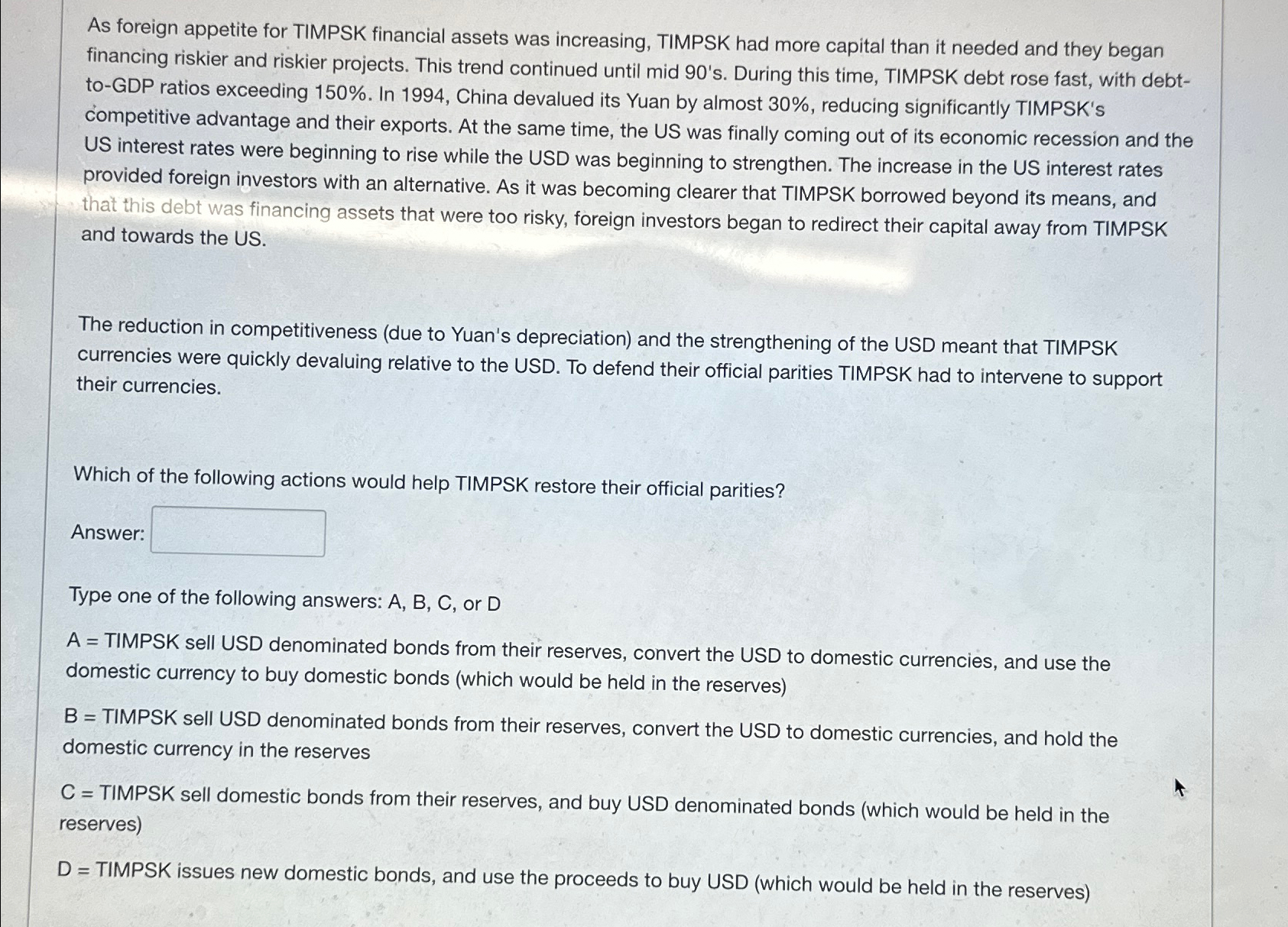Question
As foreign appetite for TIMPSK financial assets was increasing, TIMPSK had more capital than it needed and they began financing riskier and riskier projects. This
As foreign appetite for TIMPSK financial assets was increasing, TIMPSK had more capital than it needed and they began financing riskier and riskier projects. This trend continued until mid 90's. During this time, TIMPSK debt rose fast, with debtto-GDP ratios exceeding
150%. In 1994, China devalued its Yuan by almost
30%, reducing significantly TIMPSK's competitive advantage and their exports. At the same time, the US was finally coming out of its economic recession and the US interest rates were beginning to rise while the USD was beginning to strengthen. The increase in the US interest rates provided foreign investors with an alternative. As it was becoming clearer that TIMPSK borrowed beyond its means, and that this debt was financing assets that were too risky, foreign investors began to redirect their capital away from TIMPSK and towards the US.\ The reduction in competitiveness (due to Yuan's depreciation) and the strengthening of the USD meant that TIMPSK currencies were quickly devaluing relative to the USD. To defend their official parities TIMPSK had to intervene to support their currencies.\ Which of the following actions would help TIMPSK restore their official parities?\ Answer:\ Type one of the following answers:
A,B,C, or D\ A = TIMPSK sell USD denominated bonds from their reserves, convert the USD to domestic currencies, and use the domestic currency to buy domestic bonds (which would be held in the reserves)\ B = TIMPSK sell USD denominated bonds from their reserves, convert the USD to domestic currencies, and hold the domestic currency in the reserves\ C = TIMPSK sell domestic bonds from their reserves, and buy USD denominated bonds (which would be held in the reserves)\ D = TIMPSK issues new domestic bonds, and use the proceeds to buy USD (which would be held in the reserves)
 As foreign appetite for TIMPSK financial assets was increasing, TIMPSK had more capital than it needed and they began financing riskier and riskier projects. This trend continued until mid 90's. During this time, TIMPSK debt rose fast, with debtto-GDP ratios exceeding 150%. In 1994 , China devalued its Yuan by almost 30%, reducing significantly TIMPSK's competitive advantage and their exports. At the same time, the US was finally coming out of its economic recession and the US interest rates were beginning to rise while the USD was beginning to strengthen. The increase in the US interest rates provided foreign investors with an alternative. As it was becoming clearer that TIMPSK borrowed beyond its means, and that this debt was financing assets that were too risky, foreign investors began to redirect their capital away from TIMPSK and towards the US. The reduction in competitiveness (due to Yuan's depreciation) and the strengthening of the USD meant that TIMPSK currencies were quickly devaluing relative to the USD. To defend their official parities TIMPSK had to intervene to support their currencies. Which of the following actions would help TIMPSK restore their official parities? Answer: Type one of the following answers: A,B,C, or D A = TIMPSK sell USD denominated bonds from their reserves, convert the USD to domestic currencies, and use the domestic currency to buy domestic bonds (which would be held in the reserves) B = TIMPSK sell USD denominated bonds from their reserves, convert the USD to domestic currencies, and hold the domestic currency in the reserves C = TIMPSK sell domestic bonds from their reserves, and buy USD denominated bonds (which would be held in the reserves) D = TIMPSK issues new domestic bonds, and use the proceeds to buy USD (which would be held in the reserves)
As foreign appetite for TIMPSK financial assets was increasing, TIMPSK had more capital than it needed and they began financing riskier and riskier projects. This trend continued until mid 90's. During this time, TIMPSK debt rose fast, with debtto-GDP ratios exceeding 150%. In 1994 , China devalued its Yuan by almost 30%, reducing significantly TIMPSK's competitive advantage and their exports. At the same time, the US was finally coming out of its economic recession and the US interest rates were beginning to rise while the USD was beginning to strengthen. The increase in the US interest rates provided foreign investors with an alternative. As it was becoming clearer that TIMPSK borrowed beyond its means, and that this debt was financing assets that were too risky, foreign investors began to redirect their capital away from TIMPSK and towards the US. The reduction in competitiveness (due to Yuan's depreciation) and the strengthening of the USD meant that TIMPSK currencies were quickly devaluing relative to the USD. To defend their official parities TIMPSK had to intervene to support their currencies. Which of the following actions would help TIMPSK restore their official parities? Answer: Type one of the following answers: A,B,C, or D A = TIMPSK sell USD denominated bonds from their reserves, convert the USD to domestic currencies, and use the domestic currency to buy domestic bonds (which would be held in the reserves) B = TIMPSK sell USD denominated bonds from their reserves, convert the USD to domestic currencies, and hold the domestic currency in the reserves C = TIMPSK sell domestic bonds from their reserves, and buy USD denominated bonds (which would be held in the reserves) D = TIMPSK issues new domestic bonds, and use the proceeds to buy USD (which would be held in the reserves)
As foreign appetite for TIMPSK financial assets was increasing, TIMPSK had more capital than it needed and they began financing riskier and riskier projects. This trend continued until mid 90's. During this time, TIMPSK debt rose fast, with debtto-GDP ratios exceeding
150%. In 1994, China devalued its Yuan by almost
30%, reducing significantly TIMPSK's competitive advantage and their exports. At the same time, the US was finally coming out of its economic recession and the US interest rates were beginning to rise while the USD was beginning to strengthen. The increase in the US interest rates provided foreign investors with an alternative. As it was becoming clearer that TIMPSK borrowed beyond its means, and that this debt was financing assets that were too risky, foreign investors began to redirect their capital away from TIMPSK and towards the US.\ The reduction in competitiveness (due to Yuan's depreciation) and the strengthening of the USD meant that TIMPSK currencies were quickly devaluing relative to the USD. To defend their official parities TIMPSK had to intervene to support their currencies.\ Which of the following actions would help TIMPSK restore their official parities?\ Answer:\ Type one of the following answers:
A,B,C, or D\ A = TIMPSK sell USD denominated bonds from their reserves, convert the USD to domestic currencies, and use the domestic currency to buy domestic bonds (which would be held in the reserves)\ B = TIMPSK sell USD denominated bonds from their reserves, convert the USD to domestic currencies, and hold the domestic currency in the reserves\ C = TIMPSK sell domestic bonds from their reserves, and buy USD denominated bonds (which would be held in the reserves)\ D = TIMPSK issues new domestic bonds, and use the proceeds to buy USD (which would be held in the reserves)

Step by Step Solution
There are 3 Steps involved in it
Step: 1

Get Instant Access to Expert-Tailored Solutions
See step-by-step solutions with expert insights and AI powered tools for academic success
Step: 2

Step: 3

Ace Your Homework with AI
Get the answers you need in no time with our AI-driven, step-by-step assistance
Get Started


